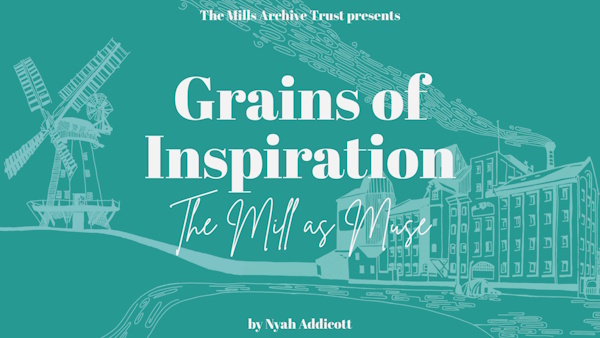| This blog is taken from our online exhibition, Grains of Inspiration: The Mill as Muse, created by intern Nyah Addicott. |
 |
| ‘The Windmill on the Onbekende Gracht’, Amsterdam, Monet, 1874. |
| In the 1800s, there was an influx of artists developing new ways to capture landscapes. Impressionism was a 19th century art movement which involved the practice of capturing light accurately within landscapes, using visible brushstrokes and an open composition. Neo-Impressionism was created as a reaction against impressionism, characterised by a more scientific and systematic approach to light and colour. This included the technique of Pointillism, where small dots of colour are applied to a canvas; the intention that they will blur together when viewing the painting from a distance. This newsletter will explore the artists who were part of these movements and used windmills as their muse. |
| Claude Monet |
 |
| ‘The Zaan at Zaandam’ by Claude Monet, 1871. |
| There are the most amusing things everywhere. Houses of every colour, hundreds of windmills and enchanting boats… Claude Monet, quote from a letter to a friend, c 1871 Claude Monet (1840-1926) was a French painter who captured landscapes in his newly invented Impressionist style. In 1871, Monet was travelling in the Netherlands, and whilst staying in a small town near Amsterdam, he painted around 20 landscapes. The weather during his visit was overcast, and the paintings from this trip were limited in colour. In 1886, Monet visited the Netherlands again. This time he spent the month in Hague, travelling around to paint the tulip fields under beautiful blue skies. |
 |
| ‘Tulip Fields With The Rijnsburg Windmill’ by Claude Monet, 1886. |
| Camille Pissarro |
 |
| ‘Windmill at Knokke, Belgium’, Camille Pissarro, 1894. |
| Camille Pissarro (1830-1903) was a Danish-French painter. Along with Monet, he was one of the first painters to explore the Impressionist style. In 1885, he met Georges Seurat and Paul Signac, who trained him in a technique called Pointillism. This theory of painting involved using very small patches of pure colour to create the illusion of blended colours and shading when viewed from a distance. This technique can be seen in these windmill paintings. Pointillism has since been used in the art of Vincent Van Gogh, who Pissarro had once advised. |
| Vincent van Gogh |
 |
| ‘Le Moulin de la Galette’, 1886. |
| Vincent van Gogh (1953-1890) was a Dutch artist who is considered an influential figure in the history of Western art; particularly in that of Post-Impressionism. In 1886, van Gogh moved from the Netherlands to Paris with his brother, Theo, to further pursue his art. He painted a series of images of a local windmill, the Moulin de la Galette, which was near his apartment in Montmartre. |
 |
| ‘Le Moulin de Blute-Fin’, 1886. |
| These windmill paintings mark a transition in van Gogh’s artistic style. Whilst his work in the Netherlands was heavy and dark, the newly adopted Impressionist style allowed him to use unrestrained brushstrokes to capture light and movement. Utilising the same subject matter for a series of paintings is fascinating, as it captures not only the weather and season but the interchanging emotions that van Gogh was feeling, allowing the viewers to connect with the artist. |
| Piet Mondrian: from Dutch Windmills to Abstract Art |
  |
| Left: ‘Mill of Heeswijk Sun’, 1904. Right: ‘Windmill in the Gein’, 1907. |
| From traditional Dutch windmill paintings to abstract art, Piet Mondrian (1872–1944) was an artist who played a pivotal role in the development of Neoplasticism. His early works, such as Mill of Heeswijk Sun (1904), reveal an impressionist influence through their thick brushwork and atmospheric treatment of light. By Windmill in the Gein (1907), he had begun to abandon naturalistic representation, adopting a more expressive palette. |
| This shift intensified in Mill in Sunlight: The Winkel Mill, 1908 (below), where Mondrian used bold, unnatural primary colours to heighten emotional impact. |
 |
| In The Red Mill, 1910 (below), the structure is reduced to flat geometric forms set against a simplified, nearly formless background, signalling a move toward abstraction. |
 |
| These evolving depictions of windmills laid the foundation for Mondrian’s mature style. Tableau I, 1921 (below) was the first of his Neoplasticism paintings, translating the structural clarity and balance first explored in his windmill paintings into pure abstraction. |
 |
| Influenced by M.H.J. Schoenmaeker’s Theory of Plastic Mathematics, Mondrian believed that harmony arose from balancing opposites. Grid-like compositions of works like Tableau I echo the rigid architectural forms of windmills, stripped of natural context and reduced to their most essential elements. |
| You can view the rest of Nyah’s exhibition here: |
 |
